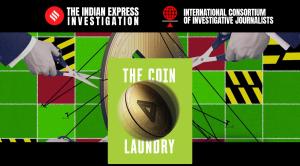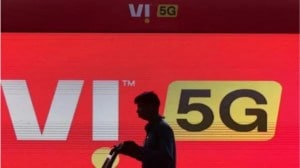
 Source: ‘India’s Arab-Mediterranean Corridor: A Paradigm Shift in Strategic Connectivity to Europe’, a paper by Michael Tanchum published by National University of Singapore and Institute of South Asian Studies. Issue No. 14, August 2021
Source: ‘India’s Arab-Mediterranean Corridor: A Paradigm Shift in Strategic Connectivity to Europe’, a paper by Michael Tanchum published by National University of Singapore and Institute of South Asian Studies. Issue No. 14, August 2021
Modi made the announcement flanked by US President Joe Biden and Saudi Arabia’s Crown Prince and Prime Minister Mohammed bin Salman Al Saud, with European Commission President Ursula von der Leyen sitting alongside, during the annual Group of 20 Leaders’ Summit in New Delhi.
Story continues below this ad
The initiative, jointly spearheaded by the US and India, spans connectivity and infrastructure running through India, Saudi Arabia, the United Arab Emirates, Jordan, Israel and the European Union. “This corridor will show a sustainable way to the whole world,” Prime Minister Modi said. “This is a big deal,” Biden said after the announcement. “This is a really big deal.”
The India-Middle East-Europe economic corridor is “nothing less than historic”, said the European Commission chief Von Der Leyen. Incidentally, the project comes at a time when India is negotiating with the EU and the UK for a comprehensive trade deal.
Official timelines for the completion of the project or details on how the project would be funded were not immediately available. While clarity on the alignment of the project was also awaited, official sources hinted at the use of existing railway links and port facilities across West Asia to align a seamless, and prioritised, multi-modal corridor that would eventually expedite trade between India and Europe, and the countries that the corridor passes through.
The use of the land route in the Arabian peninsula could mean bypassing the congested Suez Canal that cargo ships currently take. The project eventually aims at laying out a seamless corridor running all the way from South East Asia to Europe.
Story continues below this ad
An ANI tweet quoting government officials said: “India, USA, UAE, Saudi Arabia, France, Germany, Italy and the European Union Commission have signed the Memorandum of Understanding to establish the India-Middle East-Europe Economic Corridor (IMEE EC). This will encourage and provide impetus to economic development through enhanced connectivity and economic integration between Asia, West Asia/Middle East and Europe.” The MoU, it said, “will create opportunities for the promotion of trade and economic cooperation between the signatories in the fields of connectivity, logistics & freight infrastructure, clean energy & hydrogen production and energy transmission infrastructure”.
“It will facilitate and enhance the infrastructure in the logistics and transportation sector and lead to the development of significant capacities in India, thereby enhancing our self-reliance,” the agency said in the post, adding that “this is also in line with the vision of path-breaking initiative such as Make in India, Sagarmala and Atmanirbhar Bharat”.
Quoting government officials, the post said: “The IMEE EC will consist of two separate corridors (i) East Corridor connecting India to West Asia/Middle East and (il) Northern Corridor connecting West Asia/Middle East to Europe. It will include a rail line that, which upon completion, will provide a reliable and cost-effective cross-border ship-to-rail transit network to supplement the existing multi-modal transport routes enhancing transshipment of goods and services between South East Asia through India to West Asia/Middle East Europe.”
The Associated Press said in a report Saturday that way back in January, the Biden White House had started “having conversations” with regional partners about the concept. The project is learnt to be part of a US-led initiative called the Partnership for Global Infrastructure Investment (PGII), and work on this is learnt to have picked up pace at the 2023 G7 Summit in Hiroshima, Japan, in May, where G7 leaders affirmed their commitment to identify new opportunities to scale the PGII and decided that the grouping’s flagship infrastructure initiative, which had attracted major investors, would do better to respond “to the global demand for high quality infrastructure financing, in low- and middle-income countries”.
The resolution at the summit was to build out transformative economic corridors through PGII and “drive infrastructure investments that can boost and connect economic development across multiple countries and sectors”. The US imprint on the project is also evidenced by the fact that both Jordan and Israel, bitter rivals, are likely on board.
Story continues below this ad
Michael Kugelman, South Asia Institute director at The Washington DC-based Wilson Center, said the plan could be a significant response to China’s Belt and Road Initiative. “If finalised, it would be a game changer that strengthens connectivity between India and the Middle East and would aim to counter BRI,” Michael Kugelman posted on X.
Incidentally, Professor Michael Tanchum, who teaches international relations and political economy of the Middle East and North Africa at Universidad de Navarra, Spain, had in 2021 flagged the possibilities of an India-Arab-Mediterranean multi-modal corridor between Mumbai and the European mainland via the Greek transhipment port of Piraeus, the Israeli port of Haifa and Dubai port, with a significant part of the route traversing through the Saudi Arabian mainland.
For India, this new connectivity architecture could result in an alternative trans-regional commercial transportation route, joining forces in petrochemicals manufacturing by integrating India’s hydrocarbon value chain and creating an innovation corridor for green energy and innovative technology manufacturing value chains, Tanchum had noted in his paper titled ‘India’s Arab-Mediterranean Corridor: A Paradigm Shift in Strategic Connectivity to Europe’.
Incidentally, a consortium led by the Adani group had purchased the Haifa port in northern Israel in January this year. Also, reports in Greek media in recent months had alluded to India planning to explore the utilisation of Piraeus port to expedite shipments to Europe.



 Source: ‘India’s Arab-Mediterranean Corridor: A Paradigm Shift in Strategic Connectivity to Europe’, a paper by Michael Tanchum published by National University of Singapore and Institute of South Asian Studies. Issue No. 14, August 2021
Source: ‘India’s Arab-Mediterranean Corridor: A Paradigm Shift in Strategic Connectivity to Europe’, a paper by Michael Tanchum published by National University of Singapore and Institute of South Asian Studies. Issue No. 14, August 2021




































